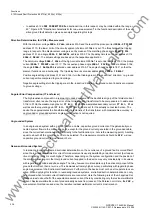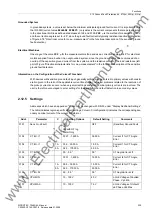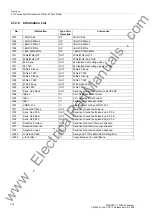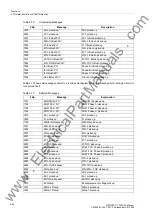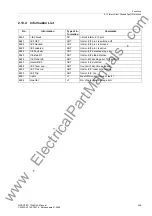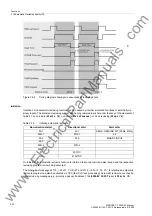
Functions
2.12 Ground Fault Protection 64, 67N(s), 50N(s), 51N(s)
SIPROTEC, 7SJ62/64, Manual
C53000-G1140-C207-2, Release date 01.2008
238
• In address
3124
PHI CORRECTION
the directional line, in this respect, may be rotated within the range
±
45°. Figure 2-78 "Directional characteristic for cos-
ϕ
-measurement" in the functional description of the sen-
sitive ground fault detection gives an example regarding this topic.
Direction Determination for V0/I0
ϕ
Measurement
With the minimum voltage
50Ns-2 Vmin
, address
3150
and the level of the pickup current
50Ns-2 PICKUP
,
address
3113
, the lower limit of the circuit segment of element 50Ns-2 is set. The thresholds of the tripping
range in respect of the displacement voltage is set by means of the matching phase angle
50Ns-2 Phi
,
address
3151
and angle
50Ns-2 DeltaPhi
, address
3152
. The trip delay time is set under address
3114
50Ns-2 DELAY
. The actual settings are based on the respective application.
The minimum voltage
50Ns-1 Vmin
of the high-current element 50Ns-1 is set under address
3153
, the pickup
current
50Ns-1 PICKUP
under
3117
. The respective phase angle
50Ns-1 Phi
is set under address
3154
,
the angle
50Ns-1 DeltaPhi
is entered under address
3155
. The angle should be set to 180° so that the
element functions non-directionally. The trip delay time is set under address
3118
50Ns-1 DELAY
.
Positive angle settings (address
3151
and
3154
) turn the tripping area in the „capacitive“ direction, i.e. ground
current capacitive compared to ground voltage.
Negative angle settings turn the tripping area in the „inductive“ direction, i.e. ground current inductive compared
to ground voltage.
Angular Error Compensation (
I
Transformer)
The high reactive component in a resonant grounded system and the inevitable air gap of the toroidal current
transformer often require the angle error of the toroidal current transformer to be compensated. In addresses
3102
to
3105
the maximum angle error
CT Err. F1
and the associated secondary current
CT Err. I1
as
well as another operating point
CT Err. F2
/
CT Err. I2
are set for the actually connected burden. The
device thus approximates the transformation characteristic of the transformer with considerable accuracy. In
ungrounded or grounded systems angle compensation is not required.
Ungrounded System
In an ungrounded system with a ground fault on a cable, capacitive ground currents of the galvanically con-
nected system flow via the measuring point, except for the ground current generated in the grounded cable,
since the current last-mentioned will flow directly to the fault location (i.e. not via the measuring point). A setting
equal to about half the ground current is to be selected. The measurement method should be
SIN
ϕ
, since
capacitive ground current is most relevant here.
Resonant-Grounded System
In resonant-grounded systems, directional determination on the occurrence of a ground fault is more difficult
since the low residual wattmetric current for measurement is usually dwarfed by a reactive current (be it capac-
itive or inductive) which is much higher. Therefore, depending on the system configuration and the position of
the arc-compensating coil, the total ground current supplied to the device may vary considerably in its values
with regard to magnitude and phase angle. The relay, however, must evaluate only the active component of the
ground fault current, that is,
I
Ns
cos
ϕ
. This demands extremely high accuracy, particularly with regard to phase
angle measurement of all instrument transformers. Furthermore, the device must not be set to operate too sen-
sitive. When applying this function in resonant-grounded systems, a reliable direction determination can only
be achieved when toroidal current transformers are connected. Here the following rule of thumb applies: Set
pickup values to about half of the expected measured current, thereby considering only the residual wattmetric
current. Residual wattmetric current predominantly derives from losses of the Petersen coil. Here, the
COS
ϕ
measurement method is used since the resistive residual wattmetric current is most relevant.
www
. ElectricalPartManuals
. com















